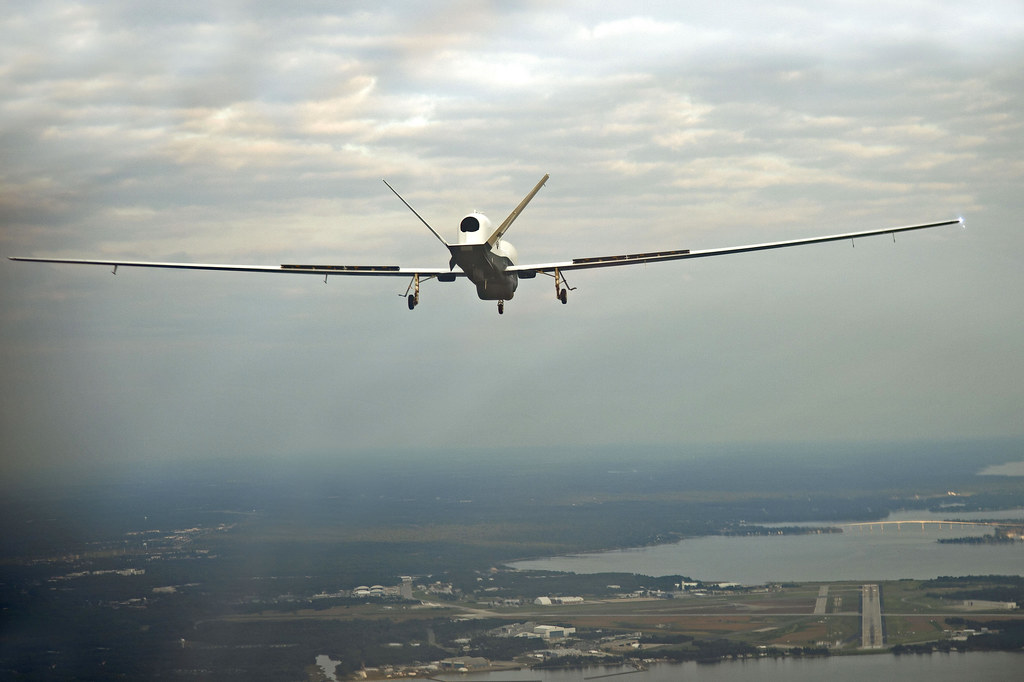Christopher Cowan, Thulasi Wigneswaran, Elisabeth Buchan and Alexander Vipond
Sea State
The US Navy will soon have eyes in the sky for much longer than before, having last week approved the commencement of low-rate initial production for the MQ-4C Triton unmanned aerial vehicle (UAV). The Triton, an intelligence, surveillance, and reconnaissance UAV, has a range of 8,200 nautical miles and can fly for up to 24 hours. This is good news for the RAAF, as it plans to fly seven Tritons alongside its future fleet of P-8 Poseidon maritime patrol aircraft to increase its broad area maritime surveillance capabilities.
The two-year saga of the two French Mistral class amphibious assault ships once destined for Russia has finally come to an end. The Egyptian Navy last week took possession of the second Mistral class vessel—named the Anwar el-Sadat after the (in)famous former Egyptian president—after receiving the first in June. While Russia may not be getting the ships it wanted, it’s trying to make the best of the situation by selling the Ka-52K attack helicopters once intended for the vessels to Egypt. The aircraft are expected to be delivered in 2017.
Flight Path
Despite its usual clandestine nature, the U-2 spy plane’s drawn a lot of attention this week after a crash in northern California. The incident, which left one pilot dead and another injured, has people asking what the relevance of the U-2 plane is today, after being introduced by Skunk Works over six decades ago. This Live Science article explores its history and current reconnaissance use. Despite its likely 2019 retirement, the US is reportedly still flying at least one U-2 at any given moment.
After 17 months of exhaustive negotiations, Dassault Aviation finally confirmed the Rafale jets deal between India and France last week. But while some analysts are detailing how the deal will give the Indian Air Force’s strike capabilities an edge, India’s Congress has been critical of the move, saying the numbers—36 jets—are insufficient to bridge the gap with Pakistan and China’s growing air strength.
It’s been over two months since the failed coup in Turkey saw around 250 Turkish Air Force fighter pilots discharged. War on the Rocks has a piece exploring the effect of the ‘pilot exodus’ on Turkey’s current Air Force operations in within the country and in Syria. This Aviation Week podcast explores similar ideas about Turkeys F-16 community.
Rapid Fire
Military leaders from NATO met in Split, Croatia last weekend to discuss the deployment of up to 4,000 personnel to the Baltic region by May 2017. Approved at the NATO Warsaw Summit in July, the force will include battalions from the 28-nation alliance, operating on a rotating basis. The force has a clear objective: to deter Russian aggression. ‘We are not talking exclusively about a training presence,’ said Czech Army Gen. Petr Pavel. ‘This force is to serve as a deterrent and if necessary as a fighting force.’ The news has produced some colourful reportage, ranging from a ‘Position of strength’ to an ‘attempt to blackmail Russia’ and even ‘WW3 Alert’.
Lockheed Martin’s Patriot Advanced Capability-3 (PAC-3) missile continues to prove its merit. The hit-to-kill interceptor successfully tracked and destroyed two tactical ballistic missile targets during a US Army test last week in New Mexico. The missiles are currently employed in allied states including the Netherlands, Germany and Japan. This infographic illustrates the role of the PAC-3 in the Ballistic Missile Defense System.
Iran released footage of the test fire of its new ‘Zolfaqar’ ballistic missile on Sunday. The missile has a range of 470 miles, and has reportedly gone into mass production. Western nations have in the past condemned similar ballistic missile tests, claiming Iran is in violation of UNSC Resolution 2231 that prohibits Iran from undertaking launches using ballistic missile technology capable of carrying nuclear weapons. Iran has denied such allegations.
Zero Gravity
US General John Hyten has called for the US to end its reliance on Russian-made rocket systems. President Obama’s nominee to take charge of STRATCOM testified before the Senate Armed Forces Committee that, if confirmed, he wouldn’t use the RD-180 Russian rocket systems. The US’s use of the rockets has been in question since Russia annexed Crimea in 2014. Hyten also outlined the development of battle management systems for space and the expansion of interagency joint space centres.
Chatham House has released a report calling for the urgent development of a ‘flexible, multilateral space and cybersecurity regime’. The report details the rapid commercialisation of space, with its authors arguing that variable state-to-state regulations will be too slow to protect satellites from multiple methods of cyber-attack. As space technology improves, the range of sectors it assists will similarly increase—including tourism and resource extraction—making this a critical juncture in ensuring international cooperation in space.
Meanwhile in China, the world’s largest radio telescope has commenced operation in Pingtang County, Guizhou on Sunday. The 1.2 billion yuan dish named FAST (five-hundred-meter aperture spherical radio telescope) is designed to look for pulsars and search for signals of alien life.
Christopher Cowan, Thulasi Wigneswaran, Elisabeth Buchan, and Alexander Vipond are research interns at ASPI. Image courtesy of Flickr user Gonzalo Alonso.
This article first appeared on the ASPI "The Strategist" Blog and is reposted here under a Creative Commons license.

